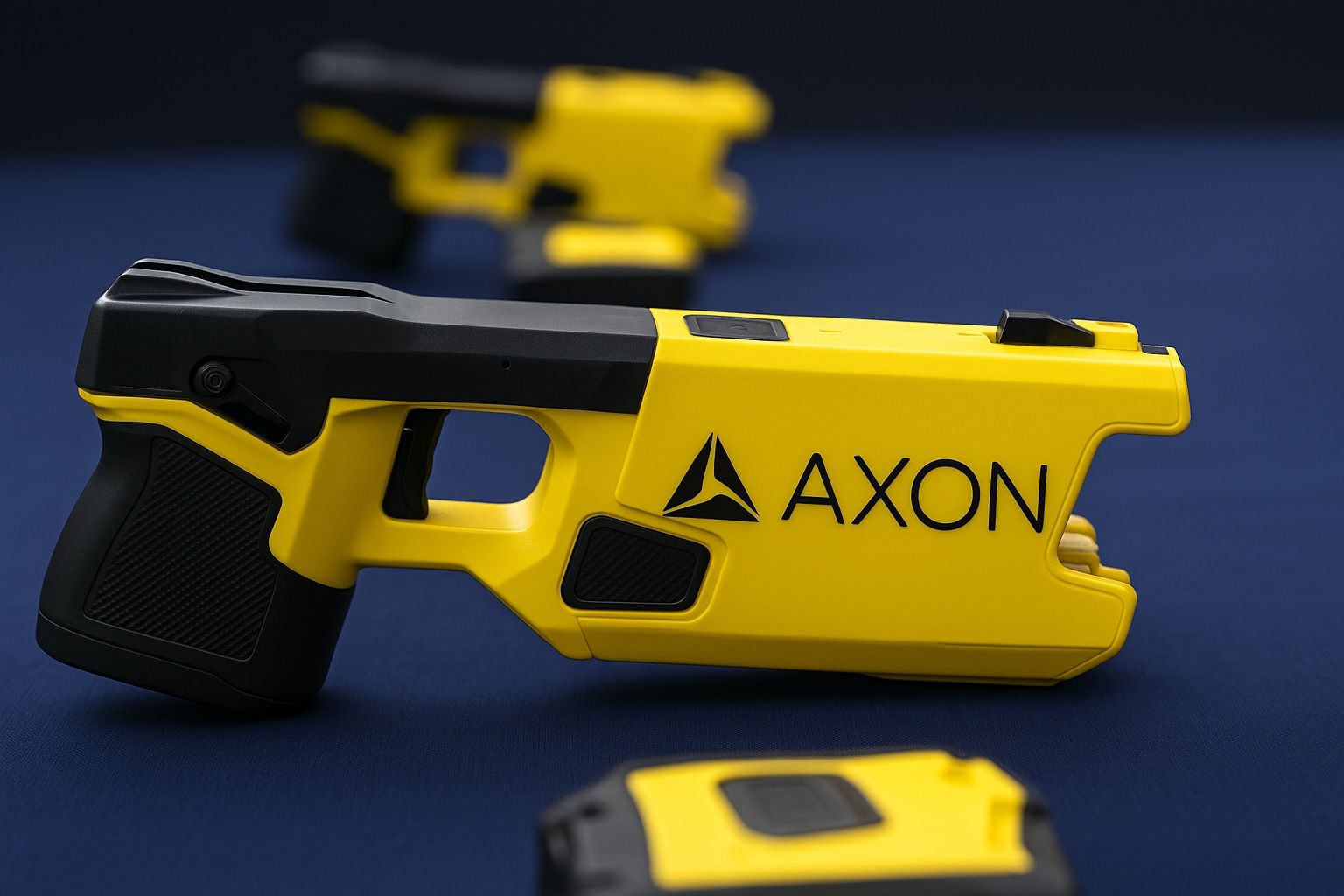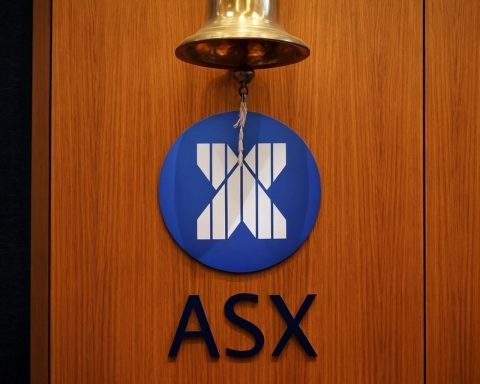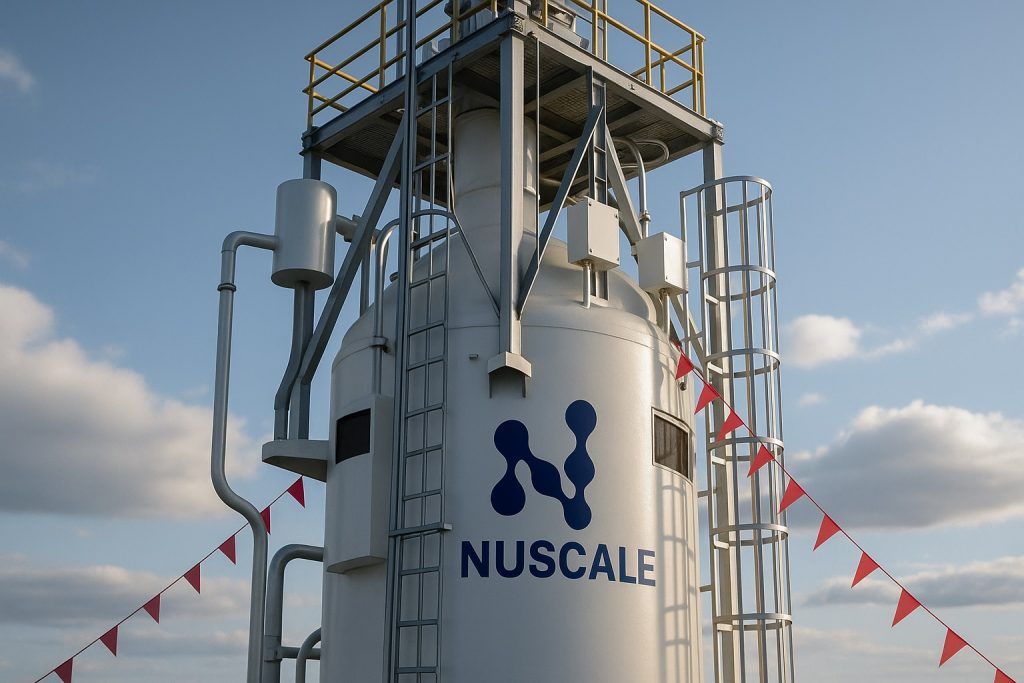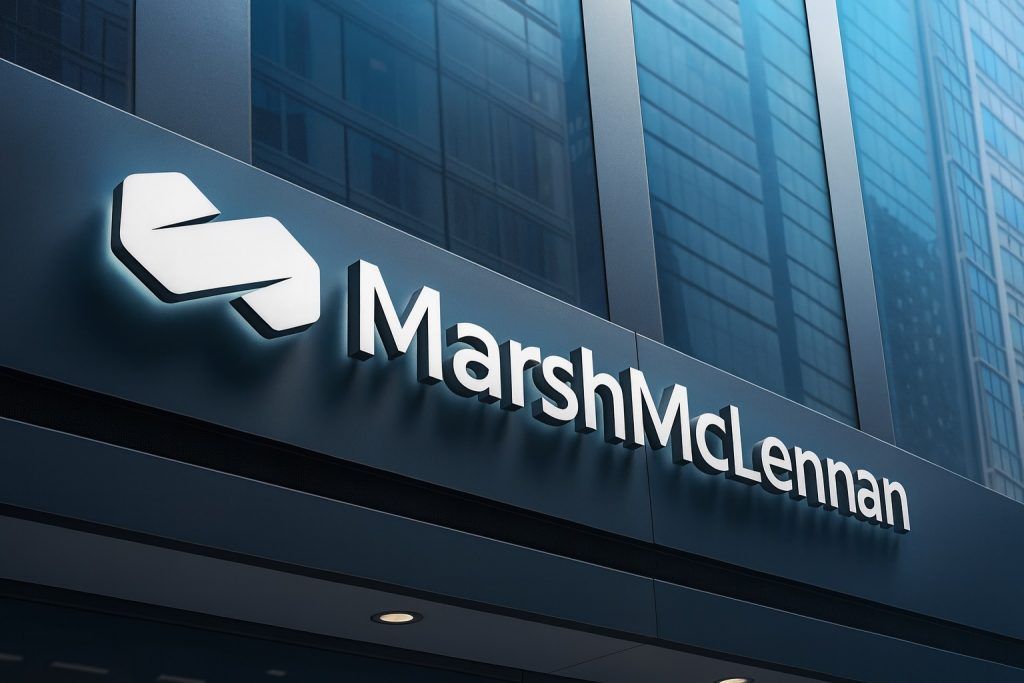- Steep Drop: Axon Enterprise (NASDAQ: AXON) shares plunged ~8.5% on Wednesday, closing at $644.99 [1]. This drop sent the stock below its 200-day moving average (around $677) [2], even as the broader market rallied (the S&P 500 rose ~0.4%, Nasdaq +0.7% on the day) [3].
- Partial Rebound:Thursday saw a rebound – Axon traded around $657 by mid-day (+1.9%) [4]. Despite the volatility, Axon remains positive for 2025, now up roughly 8–9% year-to-date [5]. Over the past 12 months the stock is still up ~62%, far outpacing the ~37% gain in the wider defense-tech industry [6].
- Strong Earnings: Axon’s growth is robust. Last quarter (Q2 2025) earnings blew past estimates at $2.12 EPS vs. $1.54 expected on revenue of $668.5 million (+32.6% year-on-year) [7]. Management hiked full-year revenue guidance to $2.65–2.73 billion (~+29% YoY) after these results [8], signaling confidence in demand for Axon’s public-safety tech.
- New AI Deals: The company is doubling down on AI and innovation. This week Axon announced the acquisition of Prepared, an AI-powered 911 communications platform, expected to close in Q4 [9]. It also launched a new Axon Body “Workforce” Mini camera, an ultra-light, AI-enhanced bodycam aimed at retail and healthcare workers [10]. Additionally, Axon partnered with TYTAN to bolster its drone-defense systems [11] – moves that expand Axon’s product ecosystem beyond policing.
- Expansion & Hurdles: Arizona’s governor approved a $1.3 billion Axon headquarters campus in Scottsdale, which CEO Rick Smith called a “defining moment” for the homegrown company [12]. However, the project faces a legal challenge from the city over zoning issues [13], potentially delaying Axon’s expansion plans.
- Competitors:Motorola Solutions (MSI) – Axon’s biggest rival in law-enforcement tech – is investing heavily. Motorola announced a $4.4 billion acquisition of Silvus Technologies to add mission-critical wireless networks for military and police clients [14]. While Axon doesn’t yet compete directly in that niche, Motorola’s move ups the competitive ante. (Notably, Motorola’s video security division pulled in $1.9 billion revenue last year, comparable to Axon’s $2.1 billion total [15].) Axon’s dominance in U.S. local police (serving ~95% of departments [16]) gives it a home-field edge, but new tech from rivals could encroach on Axon’s future growth [17].
- Analyst Outlook: Wall Street remains bullish on Axon despite the pullback. Currently 14 analysts rate it a Buy vs. 4 Hold, and the consensus price target is ~$842 per share [18] – ~30% above current levels. Top calls include Needham’s $870 target (reiterated after Axon’s Prepared deal) [19] and Bank of America’s $1,000 bull-case target [20]. Morgan Stanley and Piper Sandler likewise rate Axon “Overweight” with ~$885 targets [21]. That said, a few voices urge caution: Axon’s valuation is lofty (~175× earnings) [22], prompting Zacks Investment Research to keep a neutral Hold rating [23].
Axon Stock Sinks Despite Market Strength
Axon shares suffered an unexpected jolt mid-week, falling over 8% in a single session – a steep one-day drop for a typically steady climber. The slide to $644.99 [24] on Wednesday came with no obvious bad news from the company. In fact, broader market conditions were positive: U.S. stocks rose on the same day on optimism about trade and interest rates [25]. This made Axon’s decline stand out even more, as the stock vastly underperformed major indexes.
Technical factors likely played a role. Axon’s plunge pushed it below its 200-day moving average (~$677) [26], a key support level closely watched by traders. Breaching that threshold can trigger automated selling and shake investor confidence. TheStreet’s market analysts noted they “do not see any developments” at Axon or rival Motorola that justify such a drop, suggesting the sell-off may have been driven by profit-taking or technical trading rather than fundamentals [27] [28]. Axon’s stock had rallied over 60% in the past year [29], so some investors may have seized the chance to lock in gains.
Encouragingly, the bleeding stopped on Thursday. Axon’s shares bounced roughly +2% by midday to about $657 [30], as bargain-hunters stepped in. Even after the dip, Axon’s year-to-date performance remains in the black (≈+8%) [31], and the stock is miles above its lows from a year ago (52-week low ~$422, high ~$886) [32]. The question is whether this pullback is a temporary shakeout or a sign of deeper concerns. So far, most experts view it as an opportunity. “Given the lack of a clear negative catalyst, the recent weakness could offer a buying opportunity for long-term investors,” says one analyst, pointing to Axon’s strong growth story.
Big Growth Numbers and New AI Tech Fuel Optimism
The bullish case for Axon remains anchored in rapid growth and innovation. The company’s latest earnings underscore red-hot demand for its public safety technology. In Q2 2025, Axon’s revenue surged ~32.6% year-on-year to $668.5 million [33], handily beating forecasts. Profits followed suit – Axon earned $2.12 per share, crushing the $1.54 consensus estimate [34]. CEO Rick Smith highlighted strong uptake across Axon’s product lines, from Tasers and body-worn cameras to cloud software subscriptions. On the back of that strength, Axon raised its full-year sales outlook to ~$2.7 billion, which would mark roughly 29% growth vs. 2024 [35]. Few companies of Axon’s size are sustaining ~30% annual revenue increases, a testament to its execution in the burgeoning law enforcement tech market.
Innovation is a major driver behind these numbers. Axon is aggressively expanding its platform with acquisitions and new products – especially those leveraging artificial intelligence. Just this week, Axon announced plans to acquire Prepared, a developer of AI-enabled 911 dispatch software [36]. Prepared’s platform uses AI to integrate emergency calls, texts, videos, GPS data and even real-time translation in one system [37]. The deal (valued around $800 million, per reports) gives Axon a foothold in the emergency communications space, which the company had attempted to enter previously. Needham & Co. analysts praised the move, calling it a “significant opportunity” for Axon to improve emergency response and potentially “save both financial costs and lives” through better technology [38]. It could also pave the way for Axon to re-enter the broader 911 software market – something it tried in the past and is now revisiting with an acquisition rather than an in-house product [39].
At the same time, Axon is pushing into new customer segments. It unveiled the Axon Body 4 “Workforce” Mini, a compact body camera designed for retail, healthcare, and private security workers [40]. Lighter and smarter than police cameras, the device is “powered by AI” to help these industries bolster safety. This marks a strategic broadening of Axon’s addressable market beyond its core law enforcement base. Another recent move is Axon’s partnership with TYTAN (a defense technology firm) to integrate counter-drone capabilities into Axon’s security systems [41]. Drones are playing a growing role in security and warfare, and Axon – via its subsidiary Dedrone – is looking to offer police and military clients better tools to track and neutralize hostile drones. This partnership adds a novel interceptor technology to Axon’s toolkit.
Taken together, these initiatives show Axon is not standing still. The company is leveraging AI and strategic deals to build a comprehensive “public safety operating system.” That encompasses everything from the moment a 911 call comes in (Prepared’s domain) to the field response (body cams, drones, Tasers) and the digital evidence management after the fact (Axon’s cloud software platform). Such an end-to-end approach helps cement Axon’s market position, and it’s a key reason investors sent the stock soaring earlier this year. In fact, Axon’s shares rallied over 60% in the past 12 months partly on excitement around its AI-infused product launches and big contract wins [42]. The recent stumble doesn’t erase those developments. If Axon continues to execute – growing revenues ~30% with expanding profit margins – many believe the stock can resume its upward trajectory.
Wall Street: “Buy the Dip” as Long-Term Story Intact
Most analysts remain upbeat on Axon’s prospects and see the recent pullback as an aberration. Wall Street coverage of Axon is broadly positive, reflecting the company’s strong growth and competitive moat in its niche. According to MarketBeat data, 14 out of 18 analysts rate AXON a Buy, with only 4 Hold ratings and zero Sells [43]. The average 12-month price target is about $842 [44], which implies roughly 30% upside from current levels.
Several firms have high-conviction targets well above that. For instance, Needham reiterated its Buy rating and $870 target last month [45], right after Axon announced the Prepared acquisition. Needham’s analysts noted Axon’s “strong financial health” and listed Prepared as a catalyst to deepen Axon’s dominance in public safety data. They highlighted Axon’s impressive ~60% gross margins and ~32% revenue growth as evidence of “strong operational execution” [46]. Bank of America is even more bullish – it raised its price objective to $1,000 per share in early October, citing Axon’s “strong business momentum” and leadership in a fast-growing sector [47]. If Axon hits that four-digit target, it would mark a new all-time high well above its current ~$650s.
Other experts echo the optimism. Morgan Stanley and Piper Sandler both rate Axon Overweight (equivalent to Buy) with price targets in the mid-to-high $800s [48]. JMP Securities recently reiterated an Outperform rating with an $825 target [49], applauding Axon’s strategic acquisitions. JMP’s analyst Trevor Walsh called Axon’s purchase of Prepared “a perfect complement” to the company’s prior buys in software, reinforcing its ecosystem of connected public safety tools [50]. And in late September, TD Cowen and BofA Securities both boosted their outlooks on Axon, with BofA going to a Street-high $1,000 target as mentioned [51], and Cowen affirming an Outperform. Even some celebrity stock-pickers have taken notice – CNBC’s Jim Cramer recently lauded Axon as a company that “could continue to rally” given its pivotal role in the AI and public safety arena [52].
That said, not everyone is charging in at any price. With Axon’s shares having climbed so far so fast, valuation is a concern. The stock currently trades around 105× forward earnings and ~175× trailing earnings [53], a rich multiple even after this week’s dip. For comparison, the average price-to-earnings ratio in the defense technology industry is closer to 36× [54]. Research firm Zacks has a Hold rating (rank #3) on Axon, explicitly citing its “premium valuation” relative to peers [55]. Essentially, a lot of growth is already priced in. Any misstep – such as a revenue slowdown or contract loss – could hit the stock hard given these high expectations. Short interest in Axon has ticked up slightly in recent months (now about 2.2% of the float) [56] [57], indicating a minority of investors are betting on a come-down. Those cautious voices urge that upside and downside risks are more balanced at Axon’s current lofty valuation.
For now, however, the bulls have the louder voice. The consensus on Wall Street is that Axon’s growth story is compelling and durable. According to analysts, Axon is on track to deliver around $5.8 in EPS for full-year 2025 [58] (up sharply from $3.82 in 2024) and continue double-digit growth into 2026. If those forecasts pan out, the stock’s multiples would rapidly improve. Many analysts argue that Axon’s leadership in its field – and the largely untapped international and adjacent markets it can expand into – justifies a premium valuation. As long as Axon keeps innovating and winning new contracts, they see headroom for the stock to climb.
Axon vs. Motorola: Rivalry in Public Safety Tech
A key part of Axon’s narrative is its competition (and cooperation) with traditional defense and communications firms, especially Motorola Solutions. Axon and Motorola have a complicated relationship – they are rivals in some product lines but partners or complementary in others. Both are major suppliers of technology to law enforcement agencies, from body-worn cameras to cloud software and radios. Motorola Solutions (NYSE: MSI), known for its police radios and dispatch systems, has been expanding aggressively into Axon’s turf of late. Just a few months ago, Motorola announced a blockbuster $4.4 billion deal to acquire Silvus Technologies, a specialist in military-grade wireless networking [59]. Silvus makes mobile ad-hoc networks (MANET) used by military and special police units to maintain encrypted communications in the field without cell towers. This technology allows troops or drones to share video and data in real time, even in remote areas or warzones where traditional networks don’t work [60].
Motorola’s big buy could encroach on Axon’s future growth areas. Axon’s ecosystem currently relies on existing LTE/cellular networks or Wi-Fi for connected devices like body cameras and drones (through its Axon Air program) [61]. That works well in cities, but Motorola’s newly acquired MANET capabilities have an edge in scenarios where infrastructure is knocked out or nonexistent – think disaster zones or battlefields. If Motorola can integrate Silvus’s tech into its product lineup, it might offer police and defense customers a one-stop solution for secure voice, video, and data with or without cell service. Axon may be forced to respond, either by developing similar networking tech or partnering to avoid ceding that niche. As MarketBeat analysts noted, Motorola’s move “intensifies competition” and could make it “more difficult for Axon to expand into new use cases” unless Axon continues innovating [62]. Indeed, Axon has more than doubled its revenue from 2021 to 2024 by moving into adjacent markets, and it will need to keep doing so to sustain growth [63].
That said, Axon still enjoys significant competitive advantages. The company is deeply entrenched with law enforcement customers – it famously supplies taser weapons to over 17,000 police agencies, and its software and camera solutions are used by the vast majority of U.S. police departments. As of 2022, Axon reported it had relationships with “95% of U.S. state and local law enforcement” agencies [64]. This installed base gives Axon a robust recurring revenue stream (via subscriptions and device upgrades) and a strong position when pitching new offerings like records management or dispatch systems. Motorola, in turn, has decades-long ties on the communications side (radios, 911 dispatch consoles) and global scale. Both companies are increasingly eyeing the same total addressable market, which Axon pegs at $129 billion across public safety, defense, and personal security [65]. It’s likely we’ll see more overlap – and possibly more bidding wars or legal battles – as Axon and Motorola compete for tech contracts with police forces, federal agencies, and international clients. (The two companies have tussled in court before over patents for body cameras and related tech, though they reached a settlement in 2020.)
For investors, the Axon vs. Motorola dynamic is important. It shows that while Axon is a high-flying growth company, it’s not without serious challengers. Motorola Solutions is a $50+ billion giant that is willing to spend heavily to defend its turf (the Silvus deal is evidence). Axon’s ability to stay ahead – through R&D and strategic acquisitions – will factor into whether it can justify its rich valuation. Thus far, Axon has held its own: its one-year stock gain of ~62% dwarfs Motorola’s ~20% rise over the same period [66]. If anything, Motorola’s recent moves may validate Axon’s vision (by pouring billions into technology that complements Axon’s offerings) even as they raise the stakes. Going forward, investors will be watching how Axon navigates this rivalry, possibly seeking partnerships or further acquisitions of its own to keep its competitive edge.
Outlook: Volatility Short-Term, Growth Long-Term
Looking ahead, Axon Enterprise faces a classic high-growth quandary: can it maintain torrid growth to live up to the market’s expectations? In the near term, the stock’s volatility may continue. High-valuation tech shares like Axon can be sensitive to interest rates and market sentiment – any hint of rising yields or risk-off mood can hit them disproportionately. However, many analysts argue Axon’s recent pullback is more about market mechanics than company-specific issues. The company’s fundamentals appear as strong as ever: accelerating revenues, expanding product lines, and a mission (safer communities through technology) that has bipartisan support and increasing budget priority. As evidence of momentum, Axon’s management noted that backlog and bookings are rising alongside revenue, indicating demand pipeline remains healthy (a point highlighted by a recent analyst upgrade) [67]. The firm’s Q3 2025 earnings report, due next month, will be closely watched to confirm that growth trajectory.
Investors should also monitor external factors. Any developments in Axon’s Scottsdale HQ project could affect sentiment – a court victory clearing the way for the new campus might reassure investors about the company’s expansion plans, whereas prolonged legal wrangling could delay a key investment in Axon’s future. Regulatory and political trends around policing and defense will matter too. For instance, increased government funding for law enforcement modernization (e.g. federal grants for body cameras or public safety AI) would directly benefit Axon. Conversely, if economic conditions force municipal budget cuts, police departments might defer equipment upgrades, which could soft-pedal Axon’s growth in the short run. So far, though, the budget environment has been favorable, with many agencies prioritizing de-escalation tools and transparency (cameras) – areas Axon leads.
In summary, Axon Enterprise’s stock has hit a bump, but its long-term story remains compelling. The sudden 8% slide this week grabbed headlines, yet it appears more of a technical correction after a big run, rather than a crisis of confidence. The company’s core business – supplying Tasers, cameras, and cloud software – is firing on all cylinders, and new bets on AI and adjacent markets could unlock further growth. “Axon sits at the nexus of law enforcement gear and high-tech defense,” notes TechStock², and it has executed well enough to outpace both industries [68]. With strong support from analysts and multiple expansion drivers ahead, Axon’s path will likely continue to be one of growth tempered by bouts of volatility. For investors with an appetite for the latter, the former could make it worthwhile. The coming months will tell if Axon can justify its rich valuation – but for now, the consensus is that the long-term trajectory is still pointing up for this public safety tech leader.
Sources: Axon Enterprise investor and media reports; TechStock²/TS2 [69] [70]; Reuters [71] [72]; Investing.com [73] [74]; Smartkarma [75] [76]; MarketBeat [77] [78]; Nasdaq/BNK Invest [79] [80].
References
1. www.nasdaq.com, 2. www.nasdaq.com, 3. ts2.tech, 4. www.reuters.com, 5. www.smartkarma.com, 6. ts2.tech, 7. ts2.tech, 8. ts2.tech, 9. ts2.tech, 10. ts2.tech, 11. ts2.tech, 12. ts2.tech, 13. ts2.tech, 14. www.investing.com, 15. www.investing.com, 16. www.investing.com, 17. www.investing.com, 18. www.marketbeat.com, 19. www.investing.com, 20. www.investing.com, 21. ts2.tech, 22. ts2.tech, 23. ts2.tech, 24. www.nasdaq.com, 25. ts2.tech, 26. www.nasdaq.com, 27. www.nasdaq.com, 28. www.nasdaq.com, 29. ts2.tech, 30. www.reuters.com, 31. www.smartkarma.com, 32. www.nasdaq.com, 33. ts2.tech, 34. ts2.tech, 35. ts2.tech, 36. ts2.tech, 37. www.investing.com, 38. www.investing.com, 39. www.investing.com, 40. ts2.tech, 41. ts2.tech, 42. www.smartkarma.com, 43. www.marketbeat.com, 44. www.marketbeat.com, 45. www.investing.com, 46. www.investing.com, 47. www.investing.com, 48. ts2.tech, 49. ts2.tech, 50. ts2.tech, 51. www.investing.com, 52. www.insidermonkey.com, 53. ts2.tech, 54. www.nasdaq.com, 55. ts2.tech, 56. www.marketbeat.com, 57. www.marketbeat.com, 58. www.marketbeat.com, 59. www.investing.com, 60. www.investing.com, 61. www.investing.com, 62. www.investing.com, 63. www.investing.com, 64. www.investing.com, 65. www.investing.com, 66. ts2.tech, 67. www.investing.com, 68. ts2.tech, 69. ts2.tech, 70. ts2.tech, 71. www.reuters.com, 72. www.nasdaq.com, 73. www.investing.com, 74. www.investing.com, 75. www.smartkarma.com, 76. www.smartkarma.com, 77. www.marketbeat.com, 78. www.marketbeat.com, 79. www.nasdaq.com, 80. www.nasdaq.com







